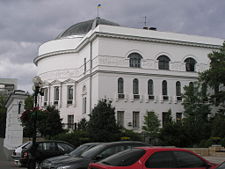
Ukrainian Club Building
Encyclopedia

Ukraine
Ukraine is a country in Eastern Europe. It has an area of 603,628 km², making it the second largest contiguous country on the European continent, after Russia...
and constructed in the times of Russian Empire
Russian Empire
The Russian Empire was a state that existed from 1721 until the Russian Revolution of 1917. It was the successor to the Tsardom of Russia and the predecessor of the Soviet Union...
in 1909-1911 by Pavlo Alyoshyn. It is located across from the building of the National Academy of Sciences of Ukraine at 54 Volodymyr Street.
Scope
It was used for many purposes, namely as the meeting place of the Ukrainian Club, Rodyna, and the Ukrainian Scientific Society. In addition, the Ukrainian Central RadaTsentralna Rada
The Tsentralna Rada or Central Rada at first was the All-Ukrainian council that united political, public, cultural, professional organizations. Later after the All-Ukrainian National Congress that council became the revolutionary parliament of Ukraine...
, a representative body formed in 1917 in Kyiv to govern the Ukrainian People's Republic
Ukrainian People's Republic
The Ukrainian People's Republic or Ukrainian National Republic was a republic that was declared in part of the territory of modern Ukraine after the Russian Revolution, eventually headed by Symon Petliura.-Revolutionary Wave:...
, was occupying the building since March 17, 1917 until April 29, 1918 with a short break during the Soviet occupation in winter of 1918. Until 1917 it was a place of the Pedagogical Museum which was renewed here in 1977. In 1930s it somewhat changed its appearance and by the design of its creator was rebuild into the museum of Lenin which was here until 1982. The first floor of the building now houses the escalators leading to the Kiev Metro
Kiev Metro
The Kiev Metro is a metro system that is the mainstay of Kiev's public transport. It was the first rapid transit system in Ukraine and the third one built in the USSR . It now has three lines with a total length of 63.7 kilometres and 49 stations...
station, Zoloti Vorota. The building is a property of Kyiv City. Along with a few municipal offices located there, a part of the building is currently subleased for office space by a set of political, civil, and small business organizations.
"Ukrainian Club" meeting place
The Ukrainian Club ' onMouseout='HidePop("59936")' href="/topics/Romanization_of_Ukrainian">tranlsit.Romanization of Ukrainian
The romanization or Latinization of Ukrainian is the representation of the Ukrainian language using Latin letters. Ukrainian is natively written in its own Ukrainian alphabet, a variation of Cyrillic....
: Ukrayins'kyi klub), was a union of national public figures of Ukraine
Ukraine
Ukraine is a country in Eastern Europe. It has an area of 603,628 km², making it the second largest contiguous country on the European continent, after Russia...
headed by Mykola Lysenko
Mykola Lysenko
Mykola Vitaliiovych Lysenko was a Ukrainian composer, pianist, conductor and ethnomusicologist.- Biography :Lysenko was born in Hrynky, Kremenchuk Povit, Poltava Governorate, the son of Vitaliy Romanovich Lysenko . From childhood he became very interested in the folksongs of Ukrainian peasants and...
. The club's meetings were attebded by the Ukrainian writers Ivan Nechuy-Levytsky
Ivan Nechuy-Levytsky
-Bioghaphy:Ivan Nechuy-Levytsky was born on 25 November 1838 to a family of a peasant priest. In 1847 entered the Boguslav religious school. Upon graduating from the Kiev Theological Academy he taught Russian language, history, and geography in the Poltava Theological Seminary and, later, in the...
, Lesya Ukrainka
Lesya Ukrainka
Larysa Petrivna Kosach-Kvitka better known under her literary pseudonym Lesya Ukrainka , was one of Ukraine's best-known poets and writers and the foremost woman writer in Ukrainian literature. She also was a political, civil, and female activist....
, her mother Olena Pchilka
Olena Pchilka
Olha Petrivna Kosach , better known by her pen name Olena Pchilka, was a Ukrainian publisher, writer, ethnographer, interpreter, civil activist. Sister of Mykhailo Drahomanov-Early years:...
, Maxim Rylsky - then a gymnasium pupil, and the actors Mariya Zankovetska and Mykola Sadovsky. In addition, Mykhailo Kotsiubynsky
Mykhailo Kotsiubynsky
Mykhailo Mykhailovych Kotsiubynsky , was a Ukrainian author whose writings described typical Ukrainian life at the start of the 20th century...
, Panas Myrny
Panas Myrny
Panas Myrny was a famous Ukrainian writer.-Biography:Panas Rudchenko was born in 1849 into a family of an accountant in Myrhorod....
, and Ivan Franko
Ivan Franko
Ivan Yakovych Franko was a Ukrainian poet, writer, social and literary critic, journalist, interpreter, economist, political activist, doctor of philosophy, the author of the first detective novels and modern poetry in the Ukrainian language....
visited the club during their stays in Kyiv.
In 1912, the Kiev City Council
Kiev City Council
Kiev City Council or Kyivrada is the city council of Kiev municipality, the highest representative body of the city community. The members of city council are directly elected by Kievans and the council is chaired by the Mayor of Kiev .The council meets in a 1950s City Council building...
had closed the Ukrainian Club, accusing it of subversive activity. But soon, another Ukrainian society, Rodyna, was arranged in the same building where the former Ukrainian Club met. When the city's administration gave permission to organize the Rodyna club, it was assumed that the stress mark was on the first syllable meant motherland, Rodina. However, the members of the club always called it Rodyna (translated as family in Ukrainian).

